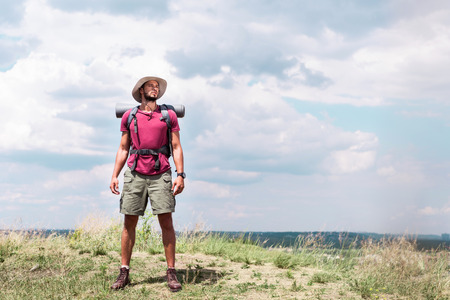Choosing Your Kit: Navigating Britain’s Weather
If you’re gearing up for a solo hike across the UK’s rugged landscapes, your first challenge is to outsmart the famously fickle British weather. Anyone who’s trekked from the misty highlands of Scotland to the wind-lashed cliffs of Cornwall knows that sunshine and squalls can trade places in the blink of an eye. When packing your kit, think in layers: start with a moisture-wicking base (merino wool or technical synthetics are winners), add an insulating mid-layer, and top it off with a reliable waterproof shell—never trust those clear skies for long. Don’t overlook proper walking trousers; quick-drying, lightweight options trump jeans every time. Invest in sturdy, well-broken-in boots and pack gaiters if you suspect boggy ground. Finally, a brimmed hat and lightweight gloves should always find room in your rucksack, ready to fend off both sunburn and sudden chills. In Britain, it’s not just about dressing for rain or shine—it’s about being ready for both within the same hour.
2. Maps, Tech, and Traditional Tools
When you’re venturing solo into the wilds of Britain—be it the mist-shrouded Lake District or the craggy ridges of Snowdonia—navigation isn’t just a nicety; it’s a lifeline. Even the most seasoned hillwalkers know that British weather can turn on a sixpence, shrouding familiar trails in fog or drenching you in relentless rain. That’s why your rucksack should always include a blend of old-school navigation tools and modern tech to keep you on track, whatever the conditions throw at you.
Ordnance Survey Maps: The Gold Standard
No matter how advanced your gadgets are, nothing beats the reliability of an Ordnance Survey (OS) map. These maps are renowned across Britain for their pinpoint detail—showing everything from ancient stone circles to the tiniest footpaths. OS Explorer (1:25,000) and Landranger (1:50,000) series are must-haves depending on your route. Waterproof versions are worth their weight in gold when the heavens open.
Navigation Essentials Comparison
| Tool | Strengths | Weaknesses |
|---|---|---|
| OS Map | Detailed, never runs out of battery, works in all conditions | Can be tricky to read in high winds/rain without protection |
| Compass | Lightweight, reliable, crucial for poor visibility navigation | Takes skill and practice to use accurately |
| GPS Device/App | Pinpoint accuracy, handy for tracking progress & emergencies | Battery-dependent, signal may drop in remote valleys |
Tech Savvy: GPS Devices and Apps
A dedicated GPS device or smartphone app (like OS Maps or ViewRanger) is brilliant for quick location checks and route recording. In an emergency, they can transmit your coordinates straight to Mountain Rescue—a real game changer. But don’t put all your eggs in one digital basket; electronics can fail when soaked or frozen. Always carry a power bank or spare batteries to keep your kit alive during multi-day treks.
Top Battery-Saving Tips for Hikers:
- Keep devices in inner pockets to protect from cold (cold zaps battery life fast)
- Switch to airplane mode when not actively navigating
- Cary a lightweight solar charger for extended trips off-grid
- Avoid using your phone as a torch unless absolutely necessary—pack a separate headlamp instead
Navigating solo across Britain’s unpredictable terrain means being ready for whatever nature throws your way. Master both map and compass skills before you set off, but don’t shun technology—when used wisely, it could tip the odds in your favour if you find yourself in a pinch.

3. First Aid and Essential Safety Gear
If you’re tackling the wilds of Britain solo, your safety arsenal needs to be up to scratch. Don’t even think about venturing onto the mist-laden moors or bracing hilltops without British-standard emergency supplies stashed in your kit. At the core is a robust bumbag first-aid kit—compact, waterproof, and packed with plasters, sterile wipes, bandages, and painkillers. Tucked snugly around your waist, it’s always within arm’s reach when disaster strikes.
No solo trekker worth their salt would be caught dead without a whistle clipped to their pack. On Britain’s sprawling fells or deep in a woodland hollow, shouting for help simply won’t cut through the elements like a sharp blast from a whistle will. Three quick blows: the universal distress signal every UK rambler should know by heart.
Visibility can drop in an instant on our unpredictable isles. That’s where high-vis gear comes into its own. Whether it’s a neon vest or reflective armbands, standing out against the monochrome greys of foggy mornings could be what makes all the difference if search parties need to spot you from afar. These simple but crucial items are non-negotiable when packing for solo British adventures—after all, fortune favours the well-prepared.
4. Fuel and Hydration: British Snacking Staples
When trekking solo across the rolling fells or remote moorlands, sustaining your energy is not just smart—it’s downright essential for survival and morale. Forget bland cereal bars; nothing quite matches the resilience and comfort of classic British snacks packed snug in your rucksack. Think pork pies, that iconic staple from Yorkshire: a golden-crusted, protein-packed boost that survives a day’s hike without fuss. Or consider the sweet, minty punch of Kendal Mint Cake—favoured by mountaineers since the days of Everest expeditions, it’s more than just sugar; it’s a time-tested jolt of energy when you’re halfway up a windswept ridge.
Hydration is equally critical. There’s no British adventure complete without the ritual of tea. A sturdy flask filled with piping hot PG Tips or Yorkshire Tea transforms a bleak, rain-lashed summit into a moment of homey comfort. Don’t just pack water—pack the means to brew up anywhere, anytime, as any seasoned rambler would advise.
Essential British Snacks for Hikers
| Snack | Why It’s Essential |
|---|---|
| Pork Pie | High in protein and fats for lasting energy; travels well without refrigeration |
| Kendal Mint Cake | Quick sugar hit for instant energy; lightweight and durable |
| Flapjack | Oat-based for slow-release carbs; easy to make at home |
| Cheddar Cheese & Oatcakes | Satisfying, robust flavours; pairs well with fruit or chutney |
Hydration on the Move
- Robust Flask: Keeps your tea hot for hours—absolutely non-negotiable for morale during those inevitable downpours.
- Refillable Water Bottle: Stash one in your pack and top up at streams using purification tablets or filters if necessary.
Packing these hearty essentials will not only keep you fuelled but also offer that distinct sense of British comfort—even when you’re miles from the nearest pub. In true British fashion, nothing lifts spirits like a good snack and a steaming cuppa brewed against an epic backdrop.
5. Wildlife and Weatherproofing Your Sleep
If you’re braving the British outdoors solo, your sleep system is your sanctuary—especially when the fickle UK weather decides to keep you on your toes. The first rule of thumb: invest in a quality bivvy bag. Unlike bulky tents, a lightweight bivvy lets you blend into wild spaces with minimal footprint—a crucial point for wild camping in UK national parks where discretion is king. Look for waterproof yet breathable fabrics; you’ll want to keep the rain out but still let condensation escape, especially during those mist-laden dawns up in the Lakes or along the Cornish coast.
Waterproof Layers: Your First Line of Defence
When it comes to layers, don’t cut corners. The British weather is notorious for its unpredictability—one minute it’s glorious sunshine, the next you’re battered by horizontal sleet. A hard-wearing waterproof shell (with taped seams) is non-negotiable, and pack an extra drybag for your sleeping kit. Even summer nights can turn soggy and cold, so ensure every layer—from thermal base to outer shell—works overtime to keep you dry and warm.
Wild Camping Etiquette in the UK
Wild camping in Britain comes with its own unwritten code. While Scotland’s right-to-roam laws offer more freedom, in England and Wales it’s all about keeping a low profile. Arrive late, leave early, and always pitch well away from paths and water sources—ideally out of sight. Leave no trace: pack out every scrap of rubbish, avoid lighting fires (opt for a stove if needed), and respect wildlife by keeping noise to a minimum. Remember, sheep are more common than bears here—but that doesn’t mean you shouldn’t store food securely to deter curious foxes or badgers!
Coastal Considerations
The British coastline throws up its own set of challenges. Salt spray, biting winds, and tides demand vigilance—check tide times meticulously before bedding down anywhere near the sea. And always anchor your bivvy well; gales can whip up without warning, turning a peaceful night into an extreme test of your kit’s limits.
Master these essentials, and your solo adventure will be as safe as it is unforgettable—whatever Britain’s wild landscapes throw at you.
6. Staying Connected: Emergency Contacts and Local Knowledge
Even the most seasoned solo hiker knows that Britain’s wild landscapes can turn perilous in a heartbeat. Whether you’re tackling the rugged Scottish Highlands, braving Dartmoor’s mists, or rambling through the Lake District’s unpredictable weather, staying connected is your lifeline. Here’s how to ensure help is never far away—even when you’re miles from the nearest village pub.
How to Access Mountain Rescue
If things go awry, the British Mountain Rescue teams are your unsung heroes. To contact them, dial 999 or 112 and ask for ‘Police’ then ‘Mountain Rescue’. Have your grid reference ready—better yet, use GPS coordinates from your phone if possible. Mobile signal may be patchy; if so, try sending a text by registering your mobile with emergencySMS before heading out. It’s a game-changer if you’re caught out on a foggy ridge with zero bars.
Register Your Route with Locals
Before lacing up your boots, pop into the nearest village shop or pub and let someone know your intended route and estimated return time. This time-honoured British custom isn’t just friendly—it could save your life. Many rural communities keep informal registers for walkers; don’t be shy about using them. In national parks, visitor centres often have official logbooks for this purpose. If you’re staying in a B&B or hostel, give them your details too—they’ll know who to call if you go missing.
Tapping into British Networks: What3Words and Beyond
The UK has embraced What3Words—a digital marvel that pinpoints your exact location down to a three-metre square. Download the app before you set off; if you get lost or injured, relay your three-word address to rescuers for pinpoint accuracy. Additionally, join local hiking Facebook groups or WhatsApp chats before your trip; these digital communities are goldmines for live updates about trail conditions and hazards. Finally, always carry a paper OS map as backup—tech can fail, but good old-fashioned navigation never lets you down.
By blending traditional British know-how with modern connectivity tools, you’ll not only stay safe but also gain a deeper appreciation of the country’s unique outdoor culture. Out there on the fells or moors, it pays to hike like a local—prepared, connected, and ready for anything Mother Nature throws at you.

